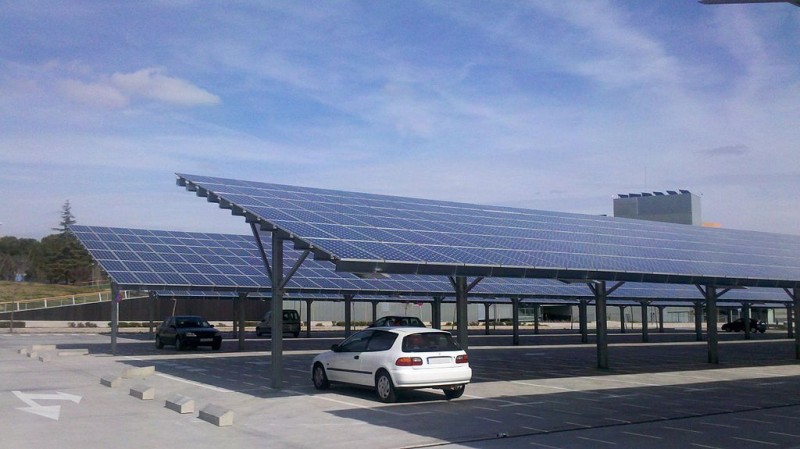Parking Lots Get Solar Canopy Makeover

A new, chic solution is targeting solar energy increase by making use of America’s unattractive parking lots: building solar canopies under which vehicles can park.
Today the largest solar parking canopy installation in the U.S. is located on the Rutgers University Livingston Campus.
The 28-acre parking lot provides 60% of Livingston Campus’ annual electricity, composed of 45 canopies with 31,032 panels of 260W each.
Unless you failed high school math, you can quickly calculate the system size to be roughly about 8 MW, which is just enough to power about 1,000 homes.
In physics, a perfect “blackbody” absorbs all incident light and reflects none. In this particular case, the definition can almost be taken literary. Ever try walking barefoot across a parking lot in 90F weather? Chances you have, and it probably felt like you were taking a guru test in India, walking on burning coal.
Black asphalt and concrete are extremely absorbent materials when it comes to sunlight.
“It’s amazing how hot these pavements get and how we’ve let them cover most of our urban surfaces,” says Haley Gilbert, a researcher in the Heat Island Group of Lawrence Berkeley National Laboratory. This results in warming the local air, contributing to what is known as the “urban heat island effect”, in which city temperatures are higher than surrounding areas. This leads to an increase of energy use and greenhouse gas emission, as well as a reduction of air and water quality.
A solution that addresses the urban heat island effect, cools down parked cars and generates energy may sound too good to be true, but it actually exists.
Solar carports is a new technology that not only embellishes the industrial appearance of parking lots, but can also generate lots of power.
Resembling a shaded picnic area, cars are parked beneath a canopy of photovoltaic cells, cooling down surrounding temperatures, even allowing for the charging of electric cars, and yes– producing electricity. How much? As with all things solar, that depends on the solar array sizes, but the above numbers definitely sound promising.
Europe is famous for its charming cobblestone streets, while parts of America bask in ugly pavement. In fact, 35 to 50 percent of surfaces in American cities are composed of asphalt and concrete according to studies performed by the Lawrence Berkeley National Laboratory. Sounds aesthetically pleasing to the eye? Not really. Sounds perfect for harnessing solar power? Maybe.
Sounds too good to be true? It’s a technology in progress. In other words, it isn’t cheap. According to Chase Weir of TruSolar, this is the most expensive type of system to build, due to engineering, steel and labor costs. But the technology is still growing, and the cost of solar canopy installation today is less than rooftop installation a few years ago.
So who knows… The days of burning the bottom of our feet with extreme heats and blowing hot air instead of AC when stepping into our parked cars may soon be behind us. Not to mention having parking lots that actually look somewhat stylish.
Sources:
- http://newscenter.lbl.gov/2012/09/13/parking-lot-science/
- http://www.epa.gov/heatislands/resources/pdf/CoolPavesCompendium.pdf
- http://solairegeneration.com/project/rutgers-university/
- http://www.washingtonpost.com/news/energy-environment/wp/2015/01/28/the-best-idea-in-a-long-time-covering-parking-lots-with-solar-panels/
Image Credit: By Hanjin (Own work) [CC BY-SA 3.0 (http://creativecommons.org/licenses/by-sa/3.0)], via Wikimedia Commons
